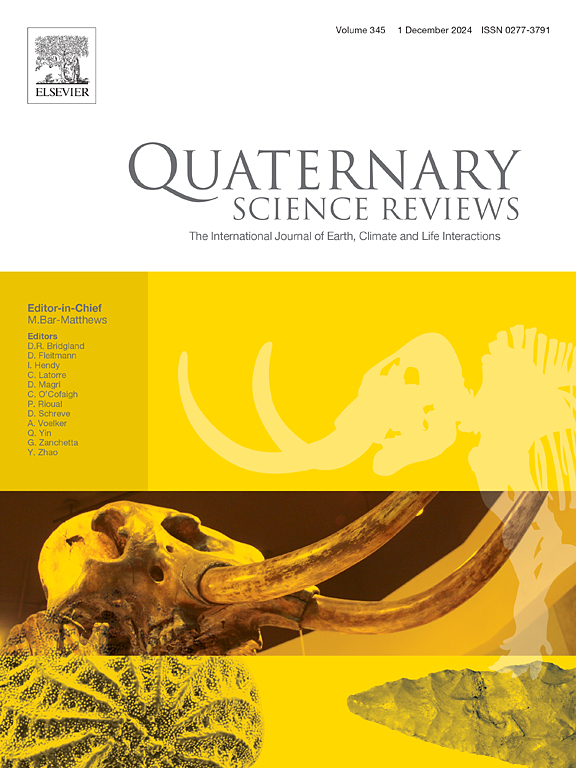南非西开普省Pinnacle Point 5-6考古沉积物的高分辨率年表
IF 3.2
1区 地球科学
Q1 GEOGRAPHY, PHYSICAL
引用次数: 0
摘要
Pinnacle Point Site 5-6 (PP5-6)是一个重要的考古和古环境遗址,位于南非南开普海岸古阿古拉斯平原边缘。为超出放射性碳测年范围的考古遗址构建高分辨率年表是一项挑战。地理年代学方法,如光学测年法,受到与感兴趣的事件直接相关的可用材料的阻碍。光学测年依赖于对随时间变化的假设,由一系列的测量组成,每个测量都有自己的随机和系统的不确定性,这些不确定性共同构成了年龄估计。在这项研究中,我们明确地接受了挑战,系统地为PP5-6制作了一个高分辨率年表,该年表由197个个体年龄估计组成,其中169个被输入贝叶斯年龄模型。PP5-6是理想的,因为它有精细的地层学,使用了现代挖掘技术,详细记录了地层学和绘制的发现。挖掘和年代测定在近二十年的时间里同时进行,为年代测定策略提供信息,为样本选择和数据分析提供背景,并将不同代理的分析规模更紧密地联系在一起。在这里,我们介绍了光学测年过程,包括仪器的灵敏度测试、数据分析程序和建模方法。然后,我们构建了一个最终的时间线,用于与其他代理数据进行比较,并解释PP5-6在~ 11万至~ 5万年前~ 6万年的沉积序列和占领。我们展示了沉积物沉积与全球气候和海平面变化的密切联系,确定了一些更新世和全新世的侵蚀事件,这些事件在沉积后改变了遗址,并在这个时间轴上放置了各种相互关联的因果关系,这些因果关系与不同类型的占领相一致。这种方法为减少年表的分辨率提供了机会,使其更接近人类的时间尺度,从而提高我们对时间变化的理解,并在其他地点和代理之间进行更直接的比较,这些地点和代理包含类似的高度确定的人类占领和变化档案。本文章由计算机程序翻译,如有差异,请以英文原文为准。
A high-resolution chronology for the archaeological deposits at Pinnacle Point 5–6, Western Cape Province, South Africa
Pinnacle Point Site 5–6 (PP5-6) is a key archaeological and paleoenvironmental site located on the edge of the Palaeo-Agulhas Plain along the southern Cape coast of South Africa. Construction of high-resolution chronologies for archaeological sites beyond the range of radiocarbon dating is challenging. Geochronological methods such as optical dating are hampered by the availability of applicable materials that are directly associated with the events of interest. Optical dating relies on assumptions made about time-dependent changes and is made up of a series of measurements each with its own random and systematic uncertainties that together make up the age estimates. In this study, we explicitly took on the challenge to systematically produce a high-resolution chronology for PP5-6 made up of 197 individual age estimates of which 169 were input into a Bayesian age model. PP5-6 is ideal because of its fine-scale stratigraphy and use of modern excavation techniques and detailed recording of stratigraphy and plotted finds. Excavations and dating took place concurrently over almost two decades to inform the dating strategy, contextualise sample choice and data analysis, and to bring the scales of analysis of different proxies closer together. Here we present the optical dating process, including sensitivity tests of our instruments, data analysis procedures and modelling approach. We then construct a final timeline for comparisons with other proxy data and interpretation of the sedimentary sequence and occupation of PP5-6 over an interval of ∼60,000 years from ∼110,000 to ∼50,000 years ago. We show how closely linked sediment deposition is to changes in global climate and sea-level, identify a few Pleistocene and Holocene erosional events that modified the site post-depositionally and place a variety of interconnected causes and effects coincident with different types of occupation on this timeline. This approach opens up opportunities to reduce the resolution of chronologies closer to the human timescales required to improve our understanding of changes through time and to make more direct comparisons between other sites and proxies that contain similarly highly resolved archives of human occupation and change.
求助全文
通过发布文献求助,成功后即可免费获取论文全文。
去求助
来源期刊

Quaternary Science Reviews
地学-地球科学综合
CiteScore
7.50
自引率
15.00%
发文量
388
审稿时长
3 months
期刊介绍:
Quaternary Science Reviews caters for all aspects of Quaternary science, and includes, for example, geology, geomorphology, geography, archaeology, soil science, palaeobotany, palaeontology, palaeoclimatology and the full range of applicable dating methods. The dividing line between what constitutes the review paper and one which contains new original data is not easy to establish, so QSR also publishes papers with new data especially if these perform a review function. All the Quaternary sciences are changing rapidly and subject to re-evaluation as the pace of discovery quickens; thus the diverse but comprehensive role of Quaternary Science Reviews keeps readers abreast of the wider issues relating to new developments in the field.
 求助内容:
求助内容: 应助结果提醒方式:
应助结果提醒方式:


